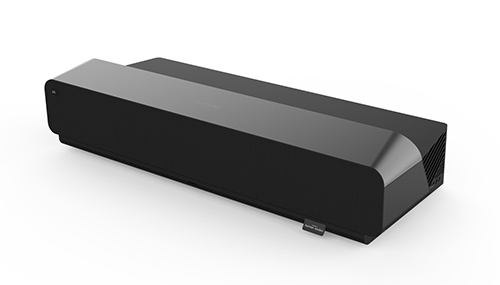DLP, LCD, LED, Laser
What is the difference between these projector technologies and how do they affect performance? Here’s an overview to help you choose your projector.
DLP
Price range: $400- $1200DLP
DLP (Digital Light Processing) is one of the first technologies developed for projectors. These projectors have a single chip containing thousands of tiny mirrors that reflect light as they move back and forth in front of a colour wheel. Each mirror handles a single pixel to give a sharp and bright image on the screen. They are very responsive and newer models can handle 3D capabilities. Manufacturers are working creating DLP projectors that can handle 4K resolutions. Their weakness is the projector lamps which last between 2000-5000 hours. They also run much hotter and need more lumens to handle ambient light. Some people can see the rainbow effect when red, green and blue are shown in high contrast areas on screen. They remain the most cost-effective projectors on the market with plenty of models of choose from.
LCD
Price range: $1200-$2000
LCD (liquid crystal display) projects light onto one mirror split into three primary colors of red, green and blue. The colors pass through separate prisms to get projected onto the screen (the liquid crystals don’t actually emit light directly). This means the LCD projector produces less heat, use less electricity and make less noise. They are best for business presentations since they handle print and spreadsheets with greater brightness in rooms with a lot of ambient light. Higher end models are also suitable for home theater set-ups. These lamps don’t contain any mercury so are more environmentally friendly. However, LCD projectors are larger and heavier so don’t work well as portable and their filters need constant maintenance. Blacks will not be as rich and may appear washed out.
LED
Price: $1200-$9000
LED (Light-emitting diode) uses electroluminescence instead of a bulb to produce light. It has a series of red, green and blue LED lights that mix together to create a white light than then gets bounced off the DLP chip. So they are very similar to DLP projectors, except they have no bulb. LED projectors have not had a good track record due to the market being flooded with poor quality counterfeits. Many LED projectors were plagued with poor lumen outputs, low quality chips and lousy images. However the industry has been hard at work upgrading the LED options and now there are some great choices with up to 3,000 lumens able to handle 4K images. The lamp can last for up to 20 years. The lamps are also mercury free. The main drawback is the price tag – these projectors are still super expensive. Many manufacturers are looking at LED/Laser projectors to drive the cost down.
LASER — No Lamp
Price: $2800-$13,000
A Laser projector does actually use laser beams to create its image. Laser Phosphor uses a single blue laser into a phosphor wheel that creates yellow that is then projected onto a color wheel that creates red and green. The RGB laser, also known as a direct laser, uses three individual lasers – one each for professional broadcasts and A/V specialists. They work best in a large area such as theaters, schools, sport stadiums or large churches were a large format is needed without sacrificing color, quality or brightness. They generate very little heat are maintenance free especially since there is no lamp replacements, are light weight and portable plus handle angle mounting with no distortion problems. And of course, 4K projection is not a problem. The only downside is the price tag. Manufacturers are working on smaller versions for the common household.
Before buying your projector, take some time to do your homework and determine both your needs and budget. There are plenty of options to choose from.








